Active Ingredient from Nottingham have always been trying to make “hard” technology a bit softer and to reveal an emotional side to it – ideally evoking that kind of feeling when the little hairs in your neck stand up. For instance their early works Ghost Engine or Chemical Garden, “a magical garden where robots roam, live webcam images from around the world are transmitted, messages can be sent, and a beautiful forest of crystal trees grow whilst you wonder”. Basically, all of their pieces are concerned with some kind of spectacle and the experience of something live and how to engage people into it. This directly lead them to working with GPS representing location in space which they want to contrast to the narrative space of imagination and which then hopefully is grown into a magical moment by the audience.
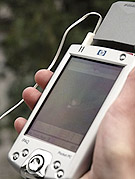
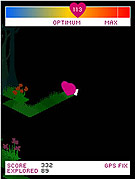
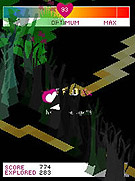 ‘Ere Be Dragons
‘Ere Be Dragons
One such project is the well-known ‘Ere Be Dragons, a game that is “using the heart as a joystick”. It came out of the notion of happiness being nothing else then total immersion into something, which lead them (not unlike Biomapping, see previous post) to look at heart rates to evaluate the level of immersion. During the game which needs no buttons or other traditional means of control, gamers become explorers of a territory created by one’s own heartbeat plus location in space. The title refers to what sailors would put into the blank spots which hadn’t been discovered yet and where fearsome monsters were suspected to be (or just to make their trips sound a bit more adventurous). Gameplay is based on five heart rate-levels ranking, with different kinds of terrain being created as (real) space is being crossed. From low (featureless desert), optimum (a lush landscape) to high (dark forest). In multiplayer mode, it is also possible to steal territory from other players and in often there were also performers in costumes which the players would encounter during the game to knit the game and the physical space together a bit more tightly.
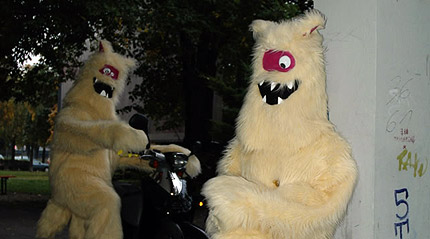
Scary monsters from ‘Ere Be Dragons
Love City was a more recent project of Active Ingredient. Set between Nottingham, Derby and Leicester – three cities which are meant to be a commercial triangle but between which there’s always been some rivalry – it aimed to “make them fall in love”. This project had to work on everyday technology, so it used a combination of SMS-messaging and the ID of the cell tower to approximately locate players. Love City is an imaginary place which is in a way was superimposed onto the real cities, so whoever was at one of the three cities’ train stations also was at Love City’s station and could communicate with people there. The main objective of the project was to establish personal, yet anonymous connections and thus build an environment through competitive flattering (!) between players. A player could compiment other players and then they would choose if they would accept it or not. Matt and Rachel had no numbers but I would suspect that there was a major boost for each city’s image of the other two (or each others inhabitants, respectively).
Sohyun Park gave a little overview of the activities at Art Center Nabi in Seoul, including again Taeyoon Choi‘s projects, the Seoul-version of Pac Manhattan and a game of chess in urban space by Bean Noh in which the players were wearing silly balloons on their heads. It would probably be too much to cover all the projects here, but it seems as if there’s loads going on in South Korea at the moment. After that, my own presentation of Blinks & Buttons, and a switch to (much more entertaining) translation mode due to the influx of non-English-speaking people for the rest of talks.
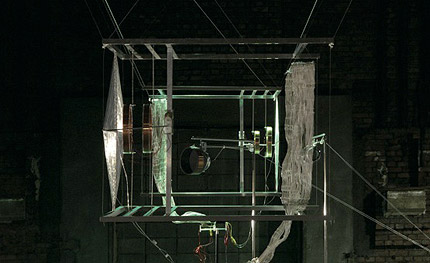 Magnetic Organ
Magnetic Organ
Yuko Mohri‘s Magnetic Organ is an installation that intentionally looks like an experimental setup from a physics lab. The piece tries to explore in how far magnetic forces, which obviously are beyond human perception, can serve as raw material for an acoustic experience in the context of an installation. It consists of a delicate setup of one motor as a generator, creating an electromagnetic field and four different coils which serve as antennas to pick up that field and convert it into sound that one can hear. The same relationship between sound, objects and space(s) is being explored with her work Composition in Progress.
It plays Vexations, Erik Satie’s early exploration into minimal music 1895 which is meant to be repeated 840 times by the pianist, “consecutively to oneself” as Satie wrote. Yuko’s piece is automatically being repeated by the computer the same amount of times but every time it is being re-recorded from the space it is exhibited in, vaguely similar to Alvin Lucier’s I Am Sitting in a Room. However, her version of Vexations includes various parameters such as, most importantly, the resonance of the space, but also other ambient noises and the repeated process of conversion between analog and digital. It’s worth mentioning that the whole process is made transparent through screens which show the software working and a sheet of paper containing the current composition is printed out with each iteration. A newer version of this project was also nominated for the Transmediale-award in 2006.
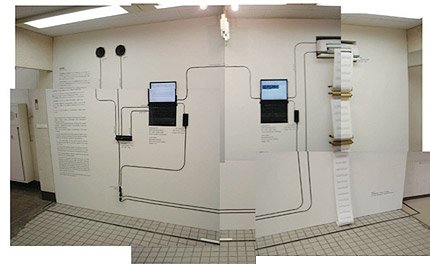 Taiwa-Hensokuki
Taiwa-Hensokuki
More projects of hers include a lovely installation in a high school-gym in which she connected a piano to the building by using thin wires in order to “play” it and a piece called Taiwa-Hensokuki which is a conversation between two speech-enabled computers that leads to increasing misunderstandings between the two robot-ladies due to the fuzzyness of the voice-recognition and the nature of the texts that they read.
The changing cultural backdrop of Korea is also one of Inyong Cho’s main subjects, more specifically the way that a family’s ancestors are being remembered. Traditionally, there is a little box (which on the pictures he was showing almost looked like a piece of furniture) that symbolically represents the space which the person still occupies. As said, this is changing along with the rest of Korean culture and to put up a website as a site of remembering is not uncommon, either because people don’t have enough time to visit an actual grave or because they might live abroad. In these cases, as Inyong described, people will actually bow to a website.
With his own project Scanmemories, he wants to elaborate on the notion of creating digital memory objects a bit further and ultimately create a company which will keep and maintain the information. Practically, a customer would upload his or her selection of memories to a protected database which then would be tied to an RFID-chip. The chip is, visibly or invisibly attached to an object of the customer’s choosing which thus becomes a kind of token for selected people to access the stored information with. The audience wasn’t too convinced by the idea of relying on a pretty specific technology like RFID when talking about decades if not centuries, but the possibility of intentionally leaving memories behind seemed to resonate with many.
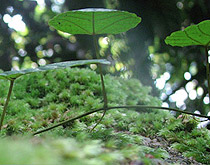
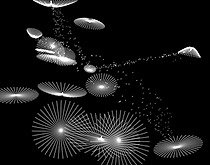 Bukit Timah, sample and result
Bukit Timah, sample and result
In the evening there were several performances by artists like Naoko Takahashi or Andreas Schlegel and Vladimir Todorovic who together form syntfarm, a quasi-scientific team who “geo-spatially explore places and facts”, meticulously collect samples and turn them into generative audiovisual performances. Specimen so far include the Bukit Timah Nature Reserve, the Kusu Anemone and soon – after a trip to Fuji-san the day before – Fuji Basalt.
